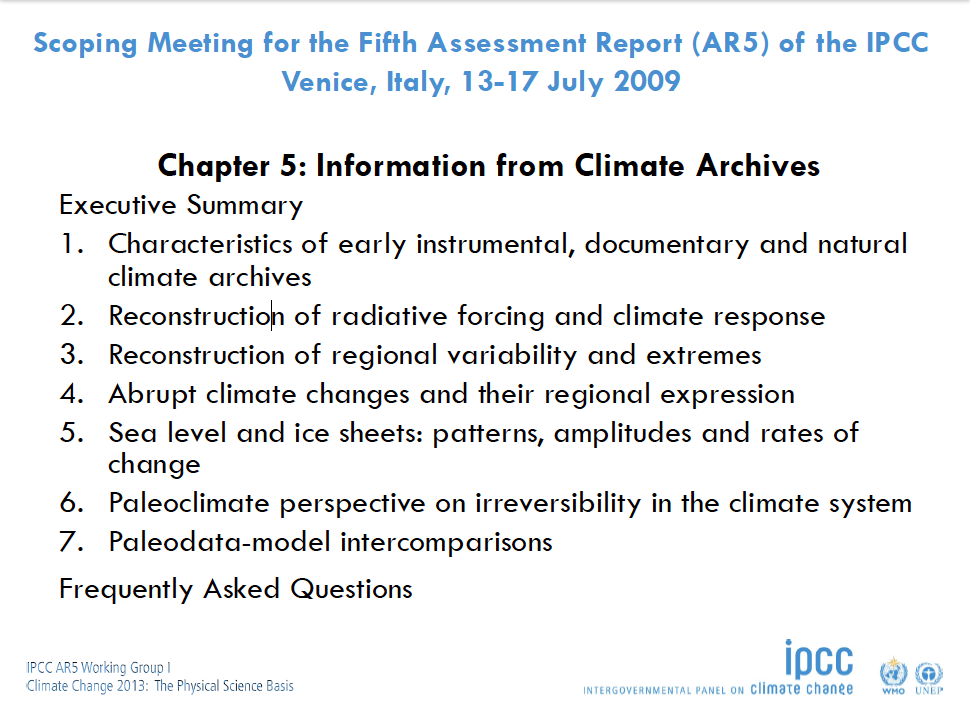3. PaleoClimate
Part three of my four part series on the IPCC is about paleoclimate: Chapter five. Bette Otto-Bliesner visited CU Boulder to personally deliver the message in the multi-part CIRES seminars, and this chapter says a lot by looking at the earth’s history, most notably through ice cores. Chapter five is where much of the evidence comes in to proving that the temperature has increased because it shows that Earth’s natural cycles have been disrupted. Weather it is tree rings, ice cores, permafrost, or other records, the evidence points to a gap between what should be happening (what we could reasonably expect from records and Earth’s experience), and what is.
The Past can Inform the Future
So how can the past inform the future? David Hume concludes that our knowledge of cause and effect is based on experience. Philosophical ambiguity aside, if we can say that if we believe that cause and effect can be predicted by experience, than we can use paleoclimate records to show how glacial and interglacial periods of old tell a different story than the one playing out now. The AR4 was the first time paleoclimate had a chapter it itself. The IPCC realized the importance of paleoclimate data, specifically relating to if 20th century warming is unusual based on the data they collected. The data collected rages in time from the Paleocene-Eocene Thermal Maximum (PETM) to the pre-industrial period (before 1850).
It’s not the Sun and It’s not Volcanic Activity
The first relevant set of models is the reconstruction of radiative forcings done through ice cores. One variable worth noting is the sun, which was proven to have much smaller variability for the last millennium than earlier reconstructions. Blaming climate variability on the sun is a known tactic for those who would deny the science suggesting anthropogenic causes of climate change. The other radiative forcing significant for a summary is the volcanic record. Another commonly touted cause by climate skeptics, many say it is the volcanoes and not humans that are putting CO2 in the air. Volcanoes do pump CO2 into the atmosphere, but to put it into perspective, human emissions are equivalent to a Mt. Pinatubo eruption every 12.5 hrs, year round. Mt. Pinatubo was .13Gt (Giga-tons) of CO2 in 1991, our emissions are 6Gt per year. The data from two reconstructions on volcanic activity show that the timing is similar, but the difference is in intensity of peaks. We know that volcanic activity contributes to global warming, but it couldn’t cause the intensity of effects without help from other sources.
CO2 Concentrations and Temperature
As for the direct CO2 measurements, the IPCC leaves no room for interpretation in their language
““It is a fact that present-day (2011) concentrations of the atmospheric greenhouse gases (GHGs) carbon dioxide (CO2), methane (CH4) and nitrous oxide (N2O) exceed the range of concentrations recorded in ice cores during the past 800,000 years.””
There you have it, straight from the horse’s mouth. Since the AR4 improvements have been made to the models, and the correlation of CO2 concentrations and polar amplification was reported with high confidence in the new models.
Temperature and Weather Events in the last Millennium
When looking at the recent data in the Northern Hemisphere, it was reported that 1983-2012 was very likely the warmest period in the last 800 years; the data also shows it was likely the warmest period in the last 1,400 years. As far as the last millennium’s other forcings, volcanic impact was greater on CO2 concentrations than solar variability. Isolated events are not enough to have caused this severe of a change, but more and more events show a trend of instability. Extreme weather events are said to be one of the markers that climate is changing rapidly. It was mentioned that mega-droughts (a drought lasting two years or longer) were found of greater magnitude and duration than those observed since the beginning of the 20th century. With drought occurring in the wetter places, the more arid places such as central Asia and South America have experienced more monsoons as well as (as we discovered before) more precipitation.
Sea Levels are Rising too Rapidly
Sea level rise may be one of the more alarming aspects to climate change. With more than 44 percent of the world’s population living on coastlines, changes to the landscape, in some places even a few feet, could have catastrophic consequences. The AR5 has addressed this by comparing paleo sea level with todays, “The rate of sea level rise since the mid-19th century has been larger than the mean rate during the previous two millennia (high confidence). Over the period 1901 to 2010, global mean sea level rose by 0.19 [0.17 to 0.21] m.” In addition, the IPCC warns that the rate of mean sea level change is unusually high in the context of centennial scale variations of the last two millennia.
We can use the past to inform the future, especially with sea level change as outlined in Bliesner’s presentation about the paleoclimate chapter. Most notably, there is a correlation between long term sea level and given temperatures found in the paleo record. With an examination on everything from evidence to mitigate the sun and volcanic activity as major causes, to looking at CO2 concentrations and temperature correlations of the last millennia we can surmise the data makes sense for anthropogenic causes. Further, the effect these causes have on sea level change is significant and very relevant to nearly half the world and the policymakers who manage that area. The IPCC has summarized paleoclimate simply, and with this information it will be easier to integrate all information for a reliable scientific document for policymakers and the public to stay informed.





